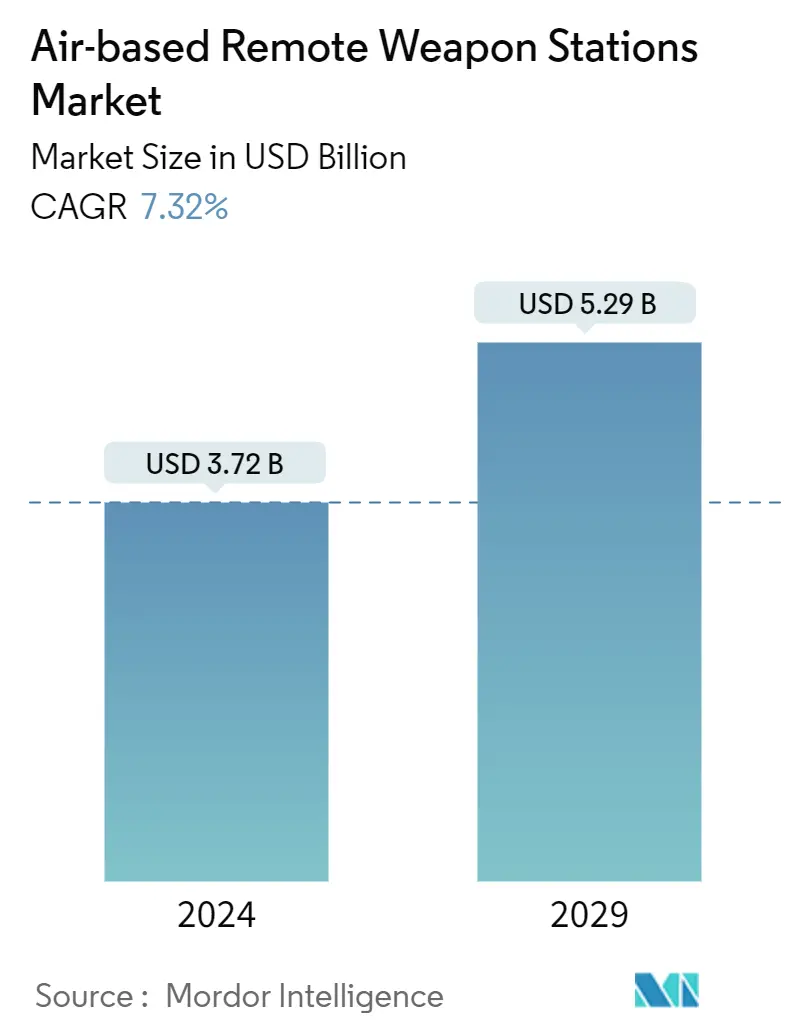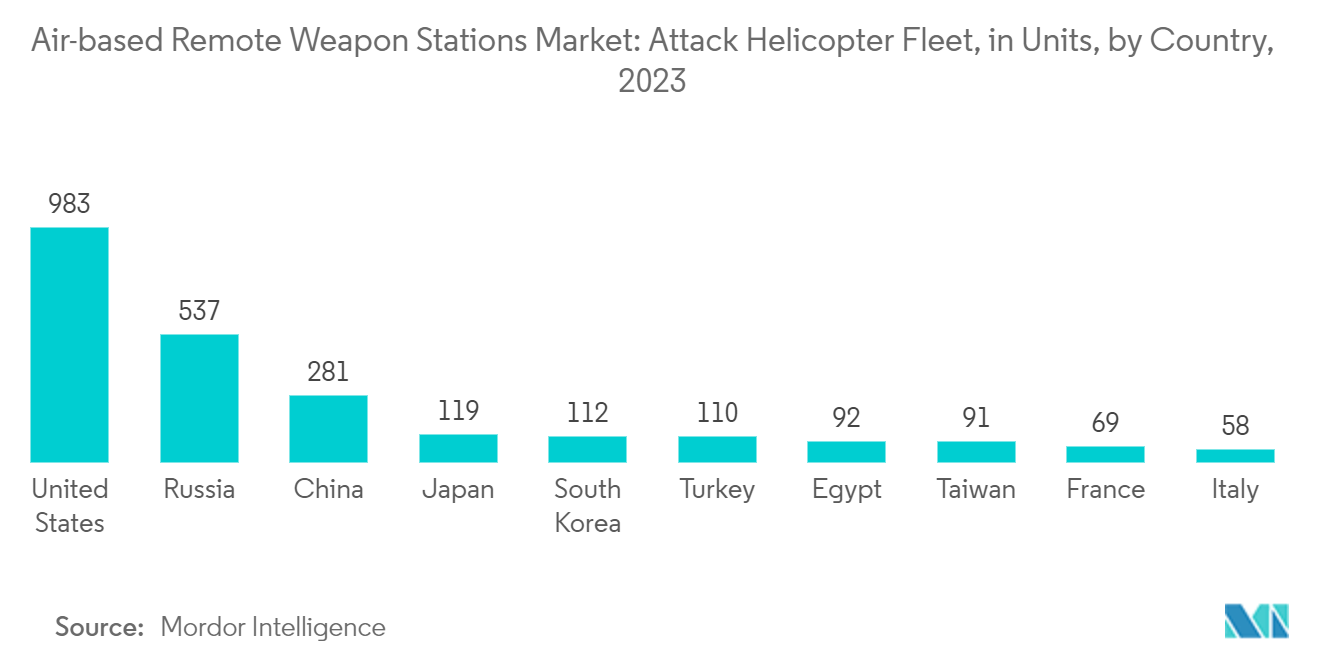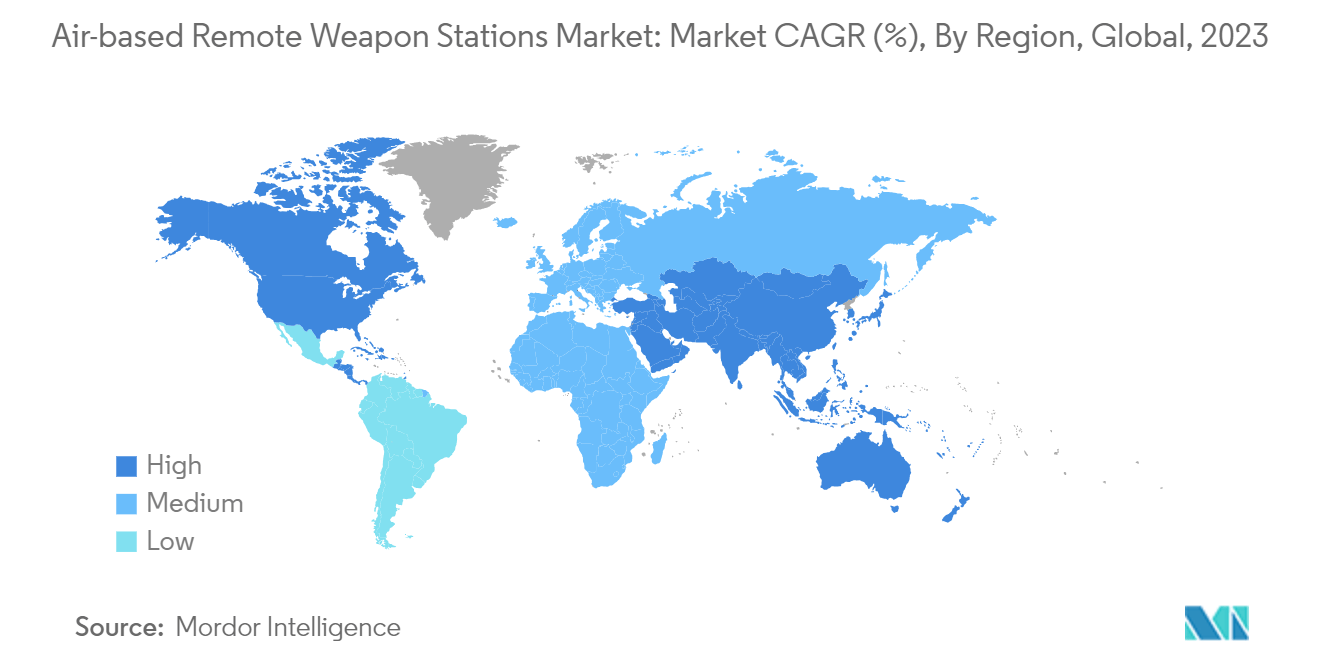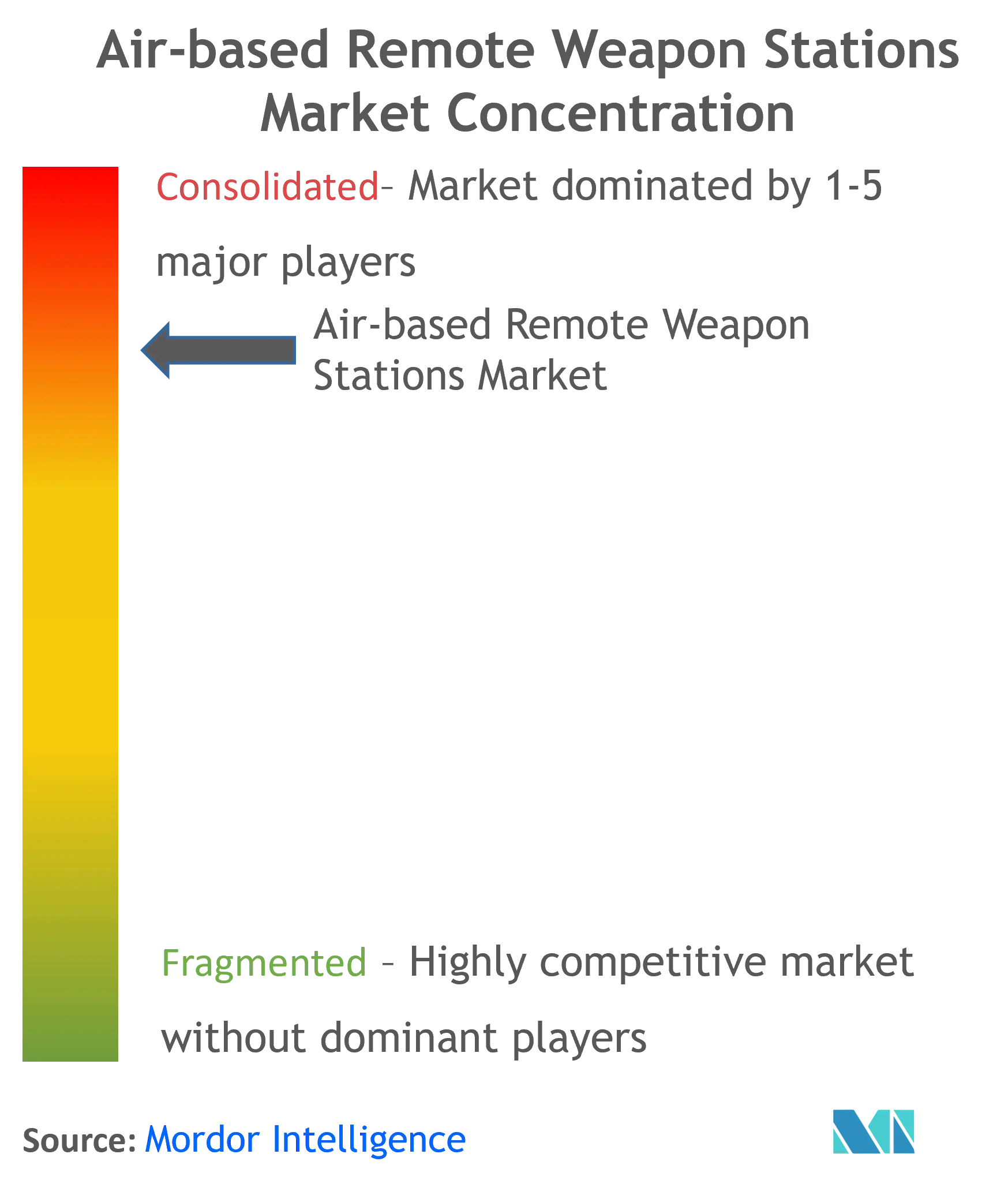Air-based Remote Weapon Stations Market Size

| Study Period | 2019 - 2029 |
| Market Size (2024) | USD 3.72 Billion |
| Market Size (2029) | USD 5.29 Billion |
| CAGR (2024 - 2029) | 7.32 % |
| Fastest Growing Market | North America |
| Largest Market | North America |
Major Players
*Disclaimer: Major Players sorted in no particular order |
Air-based Remote Weapon Stations Market Analysis
The Air-based Remote Weapon Stations Market size is estimated at USD 3.72 billion in 2024, and is expected to reach USD 5.29 billion by 2029, growing at a CAGR of 7.32% during the forecast period (2024-2029).
New technologies and platforms have transformed the warfare strategies of nations such as the United States, Russia, and China. These countries have diverted their efforts toward developing sophisticated and powerful weapons that can severely impact enemy strongholds and help attain a tactical advantage in case of an armed standoff. RWS is used extensively in current warfare scenarios due to its visual superiority and capability to perform pre-emptive strikes on specific locations. The increasing investments of armed forces and remote weapon systems manufacturers into developing advanced remote weapon stations integrated with new sensor technologies (visual systems) and firing systems (like directed energy weapons) are anticipated to bolster the market's growth in the coming years.
However, the market may be deterred by the design challenges system integrators face to incorporate advanced features in their product portfolio without compromising the payload capacity, aerodynamic profile, and range of a delivery platform. Designers must also ensure the availability of sophisticated integrated features cross-compatibility with the advanced optronic sensors and subsystems from other system manufacturers to develop a fully operational RWS, rendering a complex outlook to the overall system design.
Air-based Remote Weapon Stations Market Trends
Helicopters Segment is Projected to Dominate the Market During the Forecast Period
Airborne remote weapon systems (RWS) are primarily mounted on helicopters. Typical examples of RWS used on attack helicopters include autocannons and machine guns, which are single-barrel and rotating.
While many countries have dedicated attack helicopters that possess a wide range of armaments, there are also RWS attached to utility and transport helicopters. These customizations are being widely adopted by countries that lack the funds to procure dedicated attack helicopters. Safran’s airborne weapon systems, General Dynamics UH-1 Plank modular helicopter weapon system designed and produced for the Bell UH-1, Huey II, 212, and 412 aircraft, the Airbus HForce helicopter weapons suite, FN Herstal’s airborne pintle mounted weapon systems. Raytheon Laser weapon systems are some of the remotely operated weapon system models currently being used.
Many helicopters are being upgraded with new and advanced weapon systems. For instance, Sikorsky developed and certified a new weapons system retrofit kit for the Black Hawk helicopters. The weapons tested during the development and certification phase included fixed-forward GAU-19 and M134 guns, among others. In October 2022, the US Navy recently retired its fleet of MQ-8Bs after 13 years of service and replaced them with the larger MQ-8C. In addition, emerging technologies, like directed energy weapons, are also being tested on helicopters. Such developments will propel the growth of the market in the forecast years.

North America Will Showcase Significant Growth in the Market During the Forecast Period
Amidst escalating tensions and border disputes, countries in North America are increasing their annual defense budget for procurement of the latest combat aircraft, helicopters, and uncrewed aerial vehicles. North America, to ensure combat readiness of existing systems, several weapon modernization programs are currently underway to effectively upgrade the capabilities of the regional armed forces for effectively responding to security threats and accomplishing urgent, critical, and dangerous strategic missions.
The US is the leading user of such weapon systems in North America and is currently focusing on upgrading its existing armada. Moreover, the country is a critical global exporter and consumer of such equipment. With potential adversaries, such as Israel, Russia, and China, fielding an increasingly diverse, expansive, and modern range of regional offensive missile systems that can threaten the aerial assets of the US forces, its allies, and partners, the US-based defense contractors are actively expanding and modernizing the capabilities of their RWS portfolio. The US Department of Defense (DoD) aims to integrate the 25mm Gatling gun onboard the F-35 Joint Strike Fighter (JSF).
According to General Dynamics Corporation, the four-barrel 25mm Gatling gun can fire up to 3,300 rounds per minute to enable the aircraft to perform air-to-air attacks and close-air-support missions to troops on the ground since there are several F-35 JSFs scheduled for delivery during the forecast period. Such developments will drive the market growth in the coming years.

Air-based Remote Weapon Stations Industry Overview
The air-based remote weapon stations market is consolidated, with a few players holding significant shares in the market. Some prominent players in the market are Elbit Systems Ltd, Rafael Advanced Defense Systems Ltd, Leonardo S.p.A, General Dynamics Corporation, and BAE Systems plc.
Remote weapon systems (RWS) manufacturers invest heavily in developing RWS to increase their product portfolio. Integrating advanced sensor systems and optronic equipment is anticipated to help the companies expand their geographical presence in emerging markets. Also, the regional players in the market are collaborating with international players with technology transfer agreements for developing indigenous capabilities. Furthermore, strategic collaborations between manufacturers are on the rise to develop sophisticated systems that conform to end-user defense forces' design and performance specifications. This is expected to benefit industry stakeholders during the forecast period.
Air-based Remote Weapon Stations Market Leaders
-
BAE Systems plc
-
Elbit Systems Ltd.
-
General Dynamics Corporation
-
Leonardo S.p.A.
-
Rafael Advanced Defense Systems Ltd.
*Disclaimer: Major Players sorted in no particular order

Air-based Remote Weapon Stations Market News
- December 2022: Elbit Systems Ltd. announced it will supply the Skylark I LEX Unmanned Aerial Systems to the Australian army. Skylark I-LEX is designed for the in-house operation by the moving forces and features a 40-km Line Of Sight range that makes it useful for several roles, including force protection and reconnaissance operations.
- October 2022: The Government of India approved creating the Weapon Systems (WS) branch. The WS branch would encompass operators in four specialized streams of Surface-to-Surface missiles, Surface-to-Air missiles, Remotely Piloted Aircraft, and Weapon System Operators in twin/multi-crew aircraft. The branch will contribute immensely by enhancing the war-fighting capability of the Indian Air Force.
Air-based Remote Weapon Stations Market Report - Table of Contents
1. INTRODUCTION
- 1.1 Study Assumptions
- 1.2 Scope of the Study
2. RESEARCH METHODOLOGY
3. EXECUTIVE SUMMARY
4. MARKET DYNAMICS
- 4.1 Market Overview
- 4.2 Market Drivers
- 4.3 Market Restraints
-
4.4 Porter's Five Forces Analysis
- 4.4.1 Bargaining Power of Suppliers
- 4.4.2 Bargaining Power of Buyers/Consumers
- 4.4.3 Threat of New Entrants
- 4.4.4 Threat of Substitute Products
- 4.4.5 Intensity of Competitive Rivalry
5. MARKET SEGMENTATION
-
5.1 Component
- 5.1.1 Weaponry
- 5.1.2 Vision Systems
-
5.2 Platform
- 5.2.1 Aircraft
- 5.2.2 Helicopters
- 5.2.3 Unmanned Aerial Vehicles
-
5.3 Geography
- 5.3.1 North America
- 5.3.1.1 United States
- 5.3.1.2 Canada
- 5.3.2 Europe
- 5.3.2.1 United Kingdom
- 5.3.2.2 France
- 5.3.2.3 Germany
- 5.3.2.4 Russia
- 5.3.2.5 Rest of Europe
- 5.3.3 Asia-Pacific
- 5.3.3.1 China
- 5.3.3.2 India
- 5.3.3.3 Japan
- 5.3.3.4 South Korea
- 5.3.3.5 Rest of Asia-Pacific
- 5.3.4 Rest of the World
6. COMPETITIVE LANDSCAPE
- 6.1 Vendor Market Share
-
6.2 Company Profiles
- 6.2.1 BAE Systems plc
- 6.2.2 Duke Robotics Inc.
- 6.2.3 Elbit Systems Ltd
- 6.2.4 FN Herstal
- 6.2.5 General Dynamics Corporation
- 6.2.6 Leonardo S.p.A.
- 6.2.7 Rafael Advanced Defense Systems Ltd.
- 6.2.8 Singapore Technologies Engineering Ltd.
- 6.2.9 Saab AB
- *List Not Exhaustive
7. MARKET OPPORTUNITIES AND FUTURE TRENDS
** Subject To AvailablityAir-based Remote Weapon Stations Industry Segmentation
An air-based remote weapon station is a remotely operated weaponized system with firing and related control systems for light and medium-caliber weapons on aerial platforms.
The air-based remote weapon station market is segmented by component, platform, and geography. By component, the market is segmented into weaponry and vision systems. By platform, the market is segmented into aircraft, helicopters, and unmanned aerial vehicles. The report also covers the market sizes and forecasts for the air-based remote weapon stations market in major countries across different regions. For each segment, the market size is provided in terms of value (USD).
| Component | Weaponry | |
| Vision Systems | ||
| Platform | Aircraft | |
| Helicopters | ||
| Unmanned Aerial Vehicles | ||
| Geography | North America | United States |
| Canada | ||
| Geography | Europe | United Kingdom |
| France | ||
| Germany | ||
| Russia | ||
| Rest of Europe | ||
| Geography | Asia-Pacific | China |
| India | ||
| Japan | ||
| South Korea | ||
| Rest of Asia-Pacific | ||
| Geography | Rest of the World |
Air-based Remote Weapon Stations Market Research FAQs
How big is the Air-based Remote Weapon Stations Market?
The Air-based Remote Weapon Stations Market size is expected to reach USD 3.72 billion in 2024 and grow at a CAGR of 7.32% to reach USD 5.29 billion by 2029.
What is the current Air-based Remote Weapon Stations Market size?
In 2024, the Air-based Remote Weapon Stations Market size is expected to reach USD 3.72 billion.
Who are the key players in Air-based Remote Weapon Stations Market?
BAE Systems plc, Elbit Systems Ltd., General Dynamics Corporation, Leonardo S.p.A. and Rafael Advanced Defense Systems Ltd. are the major companies operating in the Air-based Remote Weapon Stations Market.
Which is the fastest growing region in Air-based Remote Weapon Stations Market?
North America is estimated to grow at the highest CAGR over the forecast period (2024-2029).
Which region has the biggest share in Air-based Remote Weapon Stations Market?
In 2024, the North America accounts for the largest market share in Air-based Remote Weapon Stations Market.
What years does this Air-based Remote Weapon Stations Market cover, and what was the market size in 2023?
In 2023, the Air-based Remote Weapon Stations Market size was estimated at USD 3.45 billion. The report covers the Air-based Remote Weapon Stations Market historical market size for years: 2019, 2020, 2021, 2022 and 2023. The report also forecasts the Air-based Remote Weapon Stations Market size for years: 2024, 2025, 2026, 2027, 2028 and 2029.
Air-based Remote Weapon Stations Industry Report
Statistics for the 2024 Air-based Remote Weapon Stations market share, size and revenue growth rate, created by Mordor Intelligence™ Industry Reports. Air-based Remote Weapon Stations analysis includes a market forecast outlook to for 2024 to 2029 and historical overview. Get a sample of this industry analysis as a free report PDF download.



